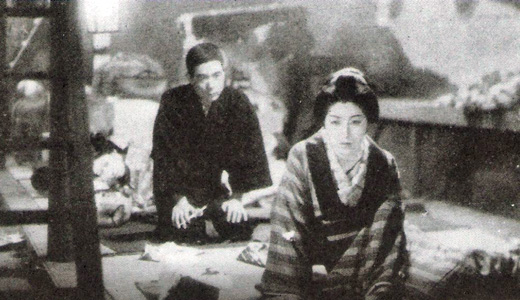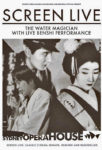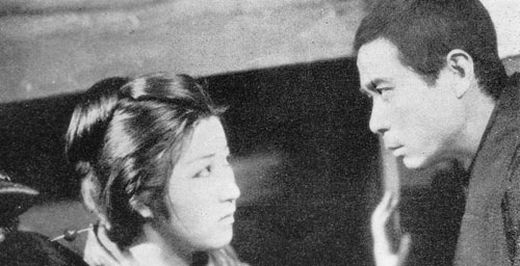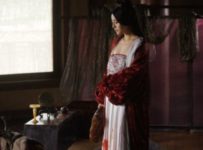Along with Akira Kurosawa and Yasujiro Ozu, prolific Japanese filmmaker Kenji Mizoguchi is considered to be one of the finest directors in Japanese cinema. Although relatively unknown internationally until after the Second World War, the director – whose greatest works include Sansho the Bailiff (Sanshō dayū) and Ugestsu – began his career in the days of silent cinema as an actor, before making his way to the director’s chair by the end of the 1920s.
Originally influenced by German Expressionism, the director would in turn influence the likes of Orson Welles and Jean-Luc Goddard. Mizoguchi would (by his own memory) complete 75 films before his premature death from leukemia, although many of the early films were lost. As such, it is a rare treat to see something like 1933’s The Water Magician (滝の白糸/Taki no Shiraito aka Taki of the Waterfall/White Threads of the Waterfall/Cascading White Threads) on the big screen.
Silent film survived in Japan beyond the introduction of sound, thanks largely to benshi (弁士), a live narration from the traditions of kabuki and noh. In benshi, the narrator stands at the side of the stage, translating the action, acting out the voices, the inter-titles and even making commentary or flamboyant asides on the narrative. Viewers of the recent season of Mizoguchi’s The Water Magician, screened as part of the Bigpond Adelaide Film Festival, were treated to a live benshi accompaniment of the film by seasoned Japanese benshi Ichiro Kataoka.
Taki (Takako Irie) is a famous water juggling performer in a travelling carnival. After falling in love with carriage driver Kinya (Tokihiko Okada), she vows to make sure he always has enough money to make his way through law school. Putting his needs first, Taki makes great sacrifices to ensure there is always money for him in every letter she sends, even if it means that she has to go without. When the money begins to run out, Taki is forced to take desperate measures to help Kinya live his dream.
The Water Magician is such a wonderful survivor of this period of Japanese film, Mizoguchi’s oldest intact film, and is largely hailed as one of the films that pushed the shinpa genre (also written as ‘shimpa’) and the birth of a theme that would follow Mizoguchi throughout his career. Toshie (2007, p.38) notes that “The shinpa films characterised by a deep sympathy for a victimised woman constitute the first important strand in his filmography”.
Based on a shinpa play by Izumi Kyoka, Tateoka Kennosuke’s script certainly uses many of the excesses of this highly melodramatic genre of film. Taki is constantly suffering at the hands of men or because of them: she pays for Kinya’s tuition, she borrows from a loan shark, she is attacked by a group of men who steal her money, she is driven to murder by the actions of a man and it is a panel of men that ultimately decide her fate. Yet this in no way diminishes the role of Taki, a strong woman who thrives in the face of adversity. Yet, as Richie (2001, p.80) points out “Redeeming such shimpa-like excesses is the physical beauty of the film’s images. The asymmetrically balanced sequences – each of which increases our understanding of the characters – carry along with them the subtext of their own aestheticism”.
Indeed, it is quite simply breathtaking that a film shot almost 80 years ago remains as fresh and compelling as it would have been for its contemporary audiences. The imagery – including the opening cart chase sequence, the ‘water magic’ tricks and the repeated motif of the bridge at three key moments in the doomed lovers’ lives – is all filled with such depth and nuance and beauty, a word that can’t be emphasised enough when speaking of Mizoguchi’s earliest surviving work.
The Water Magician contains themes that resonate well into another millennium, not to mention Mizoguchi’s later works on “fallen women”, including Osaka Elegy (1936), Sisters of the Gion (1936), The Story of the Last Chrysanthemums (1939), Women of the Night (1948) and Street of Shame (1956). Mizoguchi is often referred to as one of the first film feminists, although these films are at odds with modern conceptions of feminism, due to their depiction of women as downtrodden members of society. Yet his works were inspired by women’s suffrage (especially Victory of the Women (1946)) and unquestionably sought to bring about of equality between the sexes within the rigid Japanese cultural system that was still slowly making its way from feudalism to modernism.
There has long been a relationship between Mizoguchi’s film techniques and the traditional performing arts, so the live benshi performance that accompanied the screening was a natural fit. While it is incredibly difficult to see this kind of performance in Australia, or outside of Asia for that matter, this is truly a unique way of seeing a film. ‘Silent film’ is a bit of a misnomer, as there was always at least an organ playing, but it is unlikely people outside of Asia will have experienced a film this way before. Although the benshi performed in Japanese, with subtitles on-screen roughly approximating his script, Mike Walsh of Flinders University ponders whether “it is actually crucial to comprehend the language of the opera or benshi, and to be moved by the tradition and beauty of the native speaking voice”. The relatively young Kataoka’s face twists and contorts as his acts out the performance, emphasising not only the highly melodramatic nature of this shinpa film, but the deeply emotional connection that Japan and Japanese audiences have to this era of storytelling.
The Reel Bits: A strong early feminist work from Mizoguchi, who would create his own distinctive style by the end of the decade. It is amazing that we still have such high-quality prints of this early Mizoguchi film to be enjoyed around the world, and artists such as Ichiro Kataoka to give us a glimpse into how these films may have been enjoyed in the 1930s. While benshi may be an art that is no longer common, perhaps there is a role for it still in the century to come.
References:
Richie, D. (2001) A Hundred Years of Japanese Film. Kodanasha International: Tokyo.
Toshi, M. (2007) All For Money: Mizoguchi Kenji’s Osaka Elegy (1936). In A. Phillips and J. Stringer (Eds.) Japanese Cinema: Texts and contexts (pp. 37-49). Routledge: London and New York.







